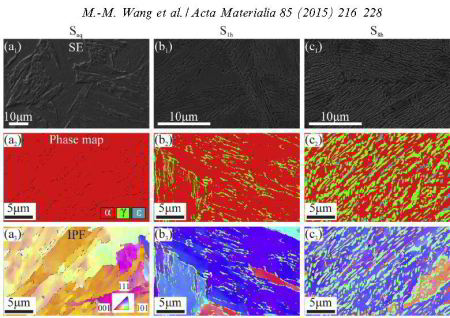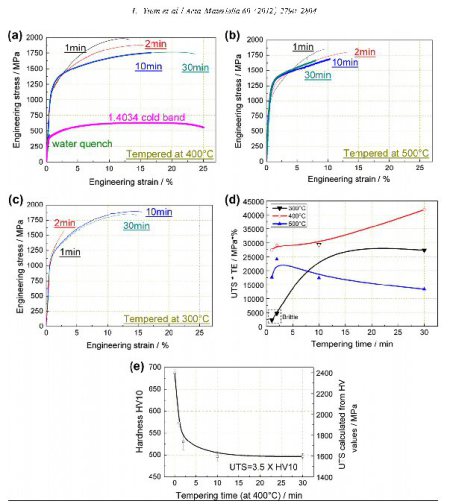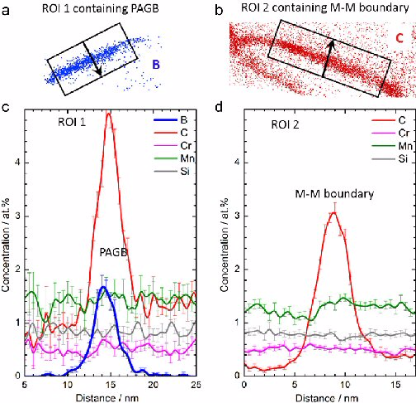Nanolaminate steels
Designing nanolaminate transformation-induced plasticity–twinning-induced plasticity steel with dynamic strain partitioning and enhanced damage resistance:
Conventional martensitic steels have limited ductility due to insufficient microstructural strain-hardening and damage resistance mechanisms.
It was recently demonstrated that the ductility and toughness of martensitic steels can be improved without sacrificing the strength, via partial reversion of the martensite back to
austenite. These improvements were attributed to the presence of the transformation-induced plasticity (TRIP) effect of the austenite phase, and the precipitation hardening (maraging) effect in
the martensitic matrix. However, a full micromechanical understanding of this ductilizing effect requires a systematic investigation of the interplay between the two phases, with regards to the
underlying deformation and damage micromechanisms. For this purpose, in this work, a Fe–9Mn–3Ni–1.4Al–0.01C (mass%) medium-Mn TRIP maraging steel is produced and heat-treated under
different reversion conditions to introduce well-controlled variations in the austenite–martensite nanolaminate
microstructure. Uniaxial tension and impact tests are carried out and the microstructure is characterized using scanning and transmission electron
microscopy based techniques and post mortem synchrotron X-ray diffraction analysis. The results reveal that (i) the strain partitioning between austenite
and martensite is governed by a highly dynamical interplay of dislocation slip, deformation-induced phase transformation (i.e. causing the TRIP effect) and mechanical twinning (i.e. causing the
twinning-induced plasticity effect); and (ii) the nanolaminate microstructure morphology leads to enhanced damage resistance. The presence of both effects results in enhanced strain-hardening
capacity and damage resistance, and hence the enhanced ductility.
Acta Materialia 85 (2015) 216-228
Acta Materialia 85 (2015) 216 Nanolamina[...]
PDF-Dokument [1.3 MB]
Acta Materialia 60 (2012) 2790-2804
Yuan et al., Nanoscale austenite reversion through partitioning, segregation and kinetic freezing: Example of a ductile 2 GPa Fe–Cr–C steel
Acta Materialia 60 (2012) 2790–2804 Aust[...]
PDF-Dokument [1.8 MB]
Austenite reversion during tempering of a Fe–13.6 Cr–0.44 C (wt.%) martensite results in an ultra-high-strength ferritic stainless steel with excellent ductility. The austenite reversion
mechanism is coupled to the kinetic freezing of carbon during low-temperature partitioning at the interfaces between martensite and retained austenite and to carbon segregation at
martensite–martensite grain boundaries. An advantage of austenite reversion is its scalability, i.e. changing tempering time and temperature tailors the desired strength–ductility profiles
(e.g. tempering at 400 °C for 1 min produces a 2 GPa ultimate tensile strength (UTS) and 14% elongation while 30 min at 400°C results in a UTS of 1.75 GPa with an elongation of 23%). The
austenite reversion process, carbide precipitation and carbon segregation have been characterized by X-ray diffraction, electron back-scatter diffraction, transmission electron microscopy and
atom probe tomography in order to develop the structure–property relationships that control the material’s strength and ductility.
Atomic scale investigation of non-equilibrium segregation of boron in a quenched Mo - free martensitic steel using atom probe tomography
Ultramicroscopy vol. 159 (2015) page 240-247
Atomic scale investigation of non-equilibrium segregation of boron in a quenched Mo - free martensitic steel using atom probe tomography
Ultramicroscopy vol. 159 (2015) page 240-247
Ultramicroscopy vol. 159 (2015) page 240-247
Ultramicroscopy159 (2015) 240 Boron segr[...]
PDF-Dokument [2.0 MB]





